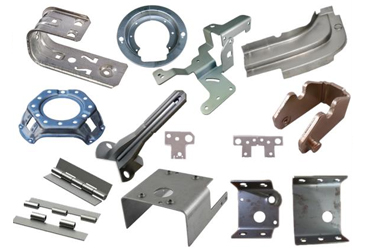Views: 15 Author: Site Editor Publish Time: 2022-06-15 Origin: Site
By using the comprehensive cold working process, manufacturers can make a variety of components from thin sheets of metal. This process, called sheet metal fabrication, is versatile and includes steps such as splicing, shearing, and riveting. Sheet metal is typically no more than 6 mm thick and is available in various types. What are the types of sheet metal?

There are five types of material for the sheet metal:
▪ Alloy Steel
▪ Stainless Steel
▪ Carbon Steel
▪ Galvanized Steel
▪ Aluminum
Alloy Steel
As the name implies, alloy steel combines multiple elements to achieve customizable properties. The primary component of this material is carbon steel. Common additions include tungsten, chromium, manganese for rigidity, vanadium, and nickel for strength. In addition to their versatility, alloy steels are very affordable.
Stainless Steel
This type of sheet metal is ideal for products often exposed to wet environments. It contains chromium, an element that significantly reduces corrosion caused by harsh or humid environments. Components made from stainless steel sheet metal can extend the life of a product or structure, from kitchen sinks to office buildings.
Carbon Steel
Iron is alloyed with carbon in this sheet metal material to provide a high-strength option. Depending on the desired application, manufacturers can choose low, medium, or high carbon content steels.
Small amounts of carbon yield a versatile material, most commonly found in everyday items such as fences and gates. Medium carbon steels are a popular choice for automobiles and appliances—higher carbon content results in a more brittle product ideal for delicate items, such as electrical wiring.
Carbon steel is available in five different grades:
Galvanized Steel
Two types of galvanized steel are available: electro-galvanized sheet and hot-dipped metal-coated sheet. The former consists of cold-rolled annealed steel. It has a pure zinc coating and no zinc highlights. The latter consists of cold-rolled hardened steel coated with pure zinc and an iron-zinc alloy. This galvanized steel has higher corrosion resistance and is more affordable than the electro-galvanized sheet.
Aluminum
Aluminum is a good choice for applications that require a lighter-weight material. This type of sheet metal provides significant corrosion resistance even without surface treatment. Aluminum is also strong and can be laser cut, welded, and machined.
The above are the 5 common types of material of sheet metal. Suppose you want to know more about sheet metal. In that case, you are welcome to collect our website. You can contact us directly if you have any business needs about sheet metal.
Dear friends, We are pleased to invite you to attend PCIM EUROPE 2025 EXHIBITION. Goldconn will be showcasing our latest innovations and technologies at Hall 6, Booth 300, which will be held at the Nuremburg, Germany, from 6th to 8th May 2025.
The Qingming Festival is an important traditional festival in our country.
https://goldconnhk.com
In order to ensure the safety of employees in the operation of equipment, our company will often hold safety production training to enhance employees' safety awareness and operation norms
Many machine parts that are important for repair and replacement are the product of metal fabrication. The importance of metal fabrication in manufacturing and industry cannot be overstated. This process plays an essential role in manufacturing and is often the foundation and support for sheet metal
USB connectors were introduced in the mid-1990s and have since evolved in size, shape, and data and power transfer capabilities. Today, the latest physical standard is Type C. In addition to greater bandwidth and bi-directionality, and reversibility, this latest iteration is capable of significantly
Many people refer to welding and metal fabrication as if they were two different words for the same process. While both processes require the use of metal, the terms are not interchangeable. Metal fabrication can be described as the process of making a product from metal. Welding is usually a part o